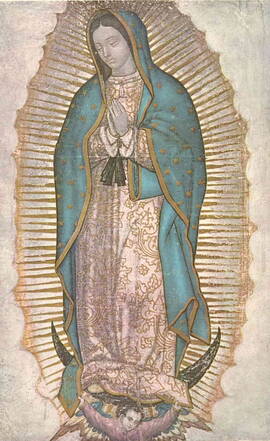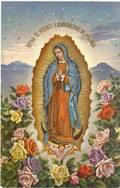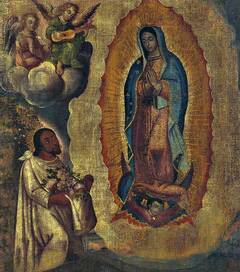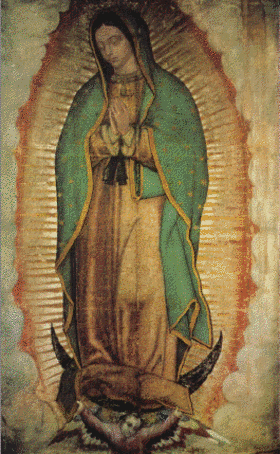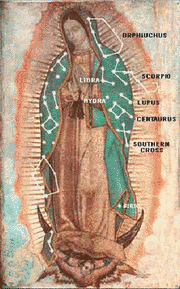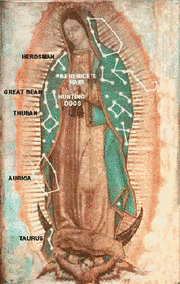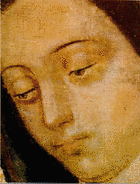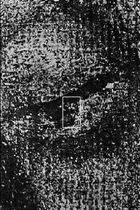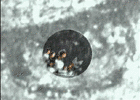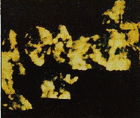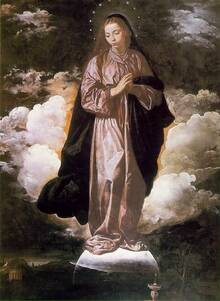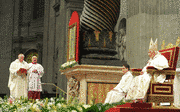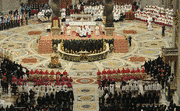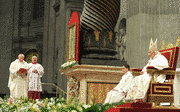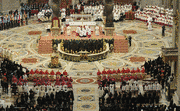Our Lady of Guadalupe
Patroness of the New Evangelization, Patroness of the Unborn & Patroness of the Americas
St John Paul II's 1st pilgrimage abroad as Pope was to Our Lady of Guadalupe in Mexico in January 1979; he next visited her in 1990 for Juan Diego's beatification, then again in 1999 & finally in 2002 for Juan Diego's canonization.
Papa Benedict XVI went to Mexico & visited Our Lady of Guadalupe in 2012.
Shrine - Basilica of Our Lady of Guadalupe, Tepeyac Hill, Mexico City
Feast day of Our Lady of Guadalupe - 12 December
Feast day of St Juan Diego Cuauhtlatoatzin - 9 December
3 2us de la Virgen de Guadalupe ![]()
con Padre José Manuel Torres Origel
3 2us by Fr Emmanuel Mansford CFR ![]()
"Over the years literally millions of Mexican Indians were converted because the image is such that Our Lady is clothed with the stars, behind her is the sun and she is standing on the moon, and so the Indians, who worshipped these pagan gods of the sun, the moon and the stars, knew that she was more powerful than them because she stood on the moon, she was in front of the sun and she was clothed in the stars. But they also knew that she wasn't God because her head was bowed and her hands were joined in prayer, and they saw that round her waist was this sash that meant that she was pregnant and right over her womb was this flower in the shape of a star which was a sign to them of the one true God."
Tom from London ![]()
"Our Lady is very special to me. I think it can be summed up in the words of Our Lady of Guadalupe when she said to Juan Diego, who had a very sick uncle. She said 'What do you fear? What troubles you? Why are you anxious, why do you fear illness? Am I not here who is your mother?' And that really sums up for me that Our Lady is all of our mothers. She is a very loving mother to all of us - she is forgiving, she is all enveloping. When I think of Our Lady all I can think of is peace and love, and just this wonderful woman who is bringing us to Christ, because that is essentially what she does."
The story of Our Lady's apparitions to Juan Diego Cuauhtlatoatzin
In Mexico in 1531, God permitted Our Lady to appear to a recently converted Aztec Indian named Juan Diego. To him was given arguably the greatest treasure in the church - the tilma of Our Lady of Guadalupe, a true image of Mary the Mother of Jesus, when she was with child.
When Juan Diego first saw the Blessed Mother, he was a 57 year old widower and she seemed to him to be about 18. She appeared to him 4 times, and once to his uncle Juan Bernadino, who was cured of his sickness. When first Juan saw her it was at the foot of the Tepeyac Hill (in what is now Mexico City). She was in a brilliant light, and called to him softly. She told him that she was the ever Virgin, Holy Mary, Mother of the True God who is the Author of Life, the Creator of all things, the Lord of Heaven and Earth, present everywhere. Her purpose in coming was to ask Juan Diego to tell the bishop that she wished a sanctuary to be erected in that place where she would be honoured.
"Here I will show myself as a loving Mother to you and to all those born in these lands, and to all those who love me and trust in me, for I am your loving mother."
When the Spanish bishop asked for a sign to prove Juan Diego's story, Our Lady gave Castille roses, which she herself arranged in the Indian's cloak or 'tilma', telling Juan to show them to no-one but the bishop. When he did so, the roses cascaded forth, revealing on the tilma a miraculous image of Our Lady as she had shown herself to Juan Diego.
Scientists from the NASA Research Centre have carried out extensive tests on the fabric and image and have discovered no scientific explanation, since the picture is neither painted, dyed or woven. It is made from the fibres of the maguey cactus and it has not been treated with sizing, a fabric of which the ordinary life span is 20 years. Enlargements were made and it was discovered that the reflection of the bishop looking in astonishment could clearly be seen in the pupil of Our Lady's eyes (more information below). This hidden miracle has been kept for the 20th century, an age where there is so little faith.
The name Guadalupe comes from an ancient shrine of Our Lady in Spain. The bishop was unable to understand the Indian name of Tecoatlexpeuh, which means "she who crushes the head of the serpent", and thought it sounded like 'de Guadalupe', by which name it has been known ever since. Within 7 years of the apparitions, 9,000,000 Indians had converted to Christianity from their pagan Aztec religion. It is the greatest outpouring of the Holy Spirit in the history of the Church.
To the Indians the picture told the great truths of Christianity. Mary is robed with the sun and is standing on the moon. The Aztecs offered human sacrifices on a massive scale so as 'to keep the natural order in creation'. She is wearing the dress of an Aztec princess, and the black sash at her waist indicates that she is pregnant. When the image was crowned by the Papal Envoy on 12th December 1981, to celebrate the 450th anniversary of the feast of the roses, a great light shone forth from her womb over the whole congregation in the Basilica. This miracle lasted for 20 minutes, could be seen by all present, and was visible even on television. Our Lady is supported by her Guardian Angel, Saint Michael. Together they brought to an end the practice of human sacrifice by the Aztecs, and together, by the power of God, they will bring to an end the killing by abortion of unborn babies in our own times.
The figure of Our Lady is 4'11" high. It is unutterably beautiful and deeply compelling. Her hands are joined in prayer. Our Lady of Guadalupe is silent and humble, but her words to Juan Diego are a comfort for us all:
"Know for certain that I am the perfect and perpetual Virgin Mary, Mother of the True God ... here I will show and offer all my love, my compassion and protection to the people. I am your merciful Mother, the Mother of all who love me, of those who cry to me, of those who have confidence in me. Here I will hear their weeping and their sorrows .. their necessities and misfortunes. Listen and let it penetrate your heart.
Do not be troubled or weighed down with grief. Do not fear any illness or vexation, anxiety or pain. Am I not here who am your Mother? Are you not under my shadow and my protection? Am I not your fountain of life? Are you not in the fold of my mantle? In the crossing of my arms? Is there anything else you need?"
Pope St John Paul II's Prayer to Our Lady of Guadalupe
25 January 1979 - in French, Portuguese & Spanish
"O Immaculate Virgin, Mother of the true God and Mother of the Church, who from this place reveal your clemency and your pity to all those who ask for your protection, hear the prayer that we address to you with filial trust, and present it to your Son Jesus, our sole Redeemer.
Mother of Mercy, Teacher of hidden and silent sacrifice, to you, who come to meet us sinners, we dedicate on this day all our being and all our love. We also dedicate to you our life, our work, our joys, our infirmities and our sorrows. Grant peace, justice and prosperity to our peoples; for we entrust to your care all that we have and all that we are, our Lady and Mother. We wish to be entirely yours and to walk with you along the way of complete faithfulness to Jesus Christ in His Church; hold us always with your loving hand.
Virgin of Guadalupe, Mother of the Americas, we pray to you for all the Bishops, that they may lead the faithful along paths of intense Christian life, of love and humble service of God and souls. Contemplate this immense harvest, and intercede with the Lord that He may instill a hunger for holiness in the whole people of God, and grant abundant vocations of priests and religious, strong in the faith and zealous dispensers of God’s mysteries.
Grant to our homes the grace of loving and respecting life in its beginnings, with the same love with which you conceived in your womb the life of the Son of God. Blessed Virgin Mary, protect our families, so that they may always be united, and bless the upbringing of our children.
Our hope, look upon us with compassion, teach us to go continually to Jesus and, if we fall, help us to rise again, to return to Him, by means of the confession of our faults and sins in the Sacrament of Penance, which gives peace to the soul.
We beg you to grant us a great love for all the holy Sacraments, which are, as it were, the signs that your Son left us on earth.
Thus, Most Holy Mother, with the peace of God in our conscience, with our hearts free from evil and hatred, we will be able to bring to all true joy and true peace, which come to us from your son, our Lord Jesus Christ, who with God the Father and the Holy Spirit, lives and reigns for ever and ever. Amen."
JPII - January 1979, on his 1st foreign trip as Pope - at the Basilica of Our Lady of Guadalupe, Mexico.
Discoveries about the tilma of the Virgin of Guadalupe
Empress of America
What science has discovered about the tilma of the Virgin of Guadalupe:
1. Ophthalmalgic studies made on the eyes of Mary detected that when the eye is exposed to light, the retina contracts, and when the light is withdrawn, it returns to a dilated state, just as happens with a living eye.
2. The temperature of Juan Diego's tilma, made of a material that comes from fibers of the maguey cactus, maintains a constant temperature of 98.6 degrees, the same as that of a living human body.
3. One of the doctors who analyzed the tilma placed his stethoscope below the black band at Mary's waist, and heard rhythmic beats at 115 pulses per minute, the same as that of a baby in the maternal womb.
4. No sign of paint has been discovered on the tilma. From a distance of 3-4 inches from the image, one can see only the maguey cactus fibers of the material: the colors disappear. Scientific studies have not been able to discover the origin of the coloration, nor the way the image was painted. They cannot detect vestiges of brush strokes or any other known painting technique. NASA scientists confirm that the paint material does not belong to any known element on earth.
5. When the material was examined under a laser ray, it was shown that there is no colouration on the front or the back of the cloth, and that the colours hover at a distance of 3/10th of a millimeter (1/100th of an inch) over the cloth, without touching it. The colours actually float above the surface of the tilma.
6. The rough material of the tilma has a lifespan of no more than 20-30 years. Several centuries ago, a replica of the image was painted on an identical piece of maguey cloth and it disintegrated after several decades. Nonetheless, during the almost 500 years of the miracle, the cloth with the image of Mary remains as strong as it was on the first day. Science cannot explain why the material has not disintegrated.
7. In the year 1791, muriatic acid accidentally spilled on the upper right side of the tilma. During the period of 30 days, without any special treatment, the affected fabric re-constituted itself miraculously.
8. The stars that appear on the mantle of Mary reflect the exact configuration of positions that could be seen in the sky of Mexico on the day the miracle happened.
On the right side of the Virgin's mantle, the southern constellations are indicated:
At the top are 4 stars that form part of the Orphiuchus constellation.
Below it to the left, we find Libra, and to its right, at what seems an arrow point, is the beginning of Scorpio.
In the middle are the constellations of Lupus and, to its left, an end point of Hydra.
Further down, we can clearly see the Southern Cross: above it appears the slightly inclined square of the Centaurus constellation.
On the left side of the Virgin's mantle we see the northern constellations:
At her shoulder, a fragment of the stars of the Herdsmanconstellation; below it and to the left is the Great Bear. To its right is Berenice's Hair; below it, Hunting Dogs, and to its left, the Thuban, which is the brightest star of the Draco constellation.
Below the 2 parallel stars (which still form part of the Big Bear) we find stars from another pair of constellations: the Auriga and, at the bottom, 3 stars of Taurus.
Thus, in their totality and proper places, the 46 most brilliant stars that can be seen on the horizon of the Valley of Mexico are identified.
9. In the year 1921, a man concealed a high power bomb in a flower arrangement and placed it at the feet of the tilma. The explosion destroyed everything around it, except for the tilma which remained intact.
10. Scientists discovered that the eyes of Mary have the 3 refractive characteristics of a human eye.
11. In the eyes of Mary (only about 1/3rd inch in size), miniscule human figures were discovered that no artist could have painted. The same scene is repeated in each eye.
Using digital technology, the images in the eyes were enlarged many times, revealing that each eye reflected the figure of the Indian Juan Diego opening his tilma in front of Bishop Zumarraga. Do you know the size of this scene? One fourth of a millimeter (1/100th of an inch).
It is evident that all these unexplainable things were given to us for a reason.
In the Indian language, 'Guadalupe' means to "crush the head of the serpent." It properly refers to Genesis 3:15 - Mary, the conqueror of evil. The image also depicts a detail from Apocalypse 12: "And a great sign appeared in Heaven: a woman clothed with the sun and the moon under her feet." The Virgin wears a black band at her waist, which symbolizes pregnancy, to indicate that God wanted Jesus to be born in the 3 Americas, in the heart of each American. "While I live I will praise the Lord: I will sing praise unto my God while I have any being" (Ps 146:2)
For more info about this presentation put together by Andre Fernando Garcia, click here.
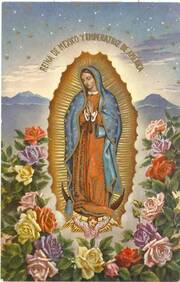
The Virgin will be with you always, whenever you need her - she will never abandon you.
You will always be Mary's special son or daughter. Never forget the words Mary spoke to Juan Diego:
"My little child, the smallest of all, let nothing afflict you.
Do you not know that you are in my lap?
Am I not here, I, who am your mother?"
Pope St John Paul II's homily at Mass on 450th anniversary of the apparition of Our Lady of Guadalupe
St Peter's Basilica, 12th December 1981 - also in French, Portuguese & Spanish
"Signori Cardinali, Cari fratelli nell’Episcopato,
amatissimi fratelli e sorelle,
1. Con la celebrazione di questa Eucaristia desidero partecipare con voi, accanto all’altare del Signore, in un atto di omaggio filiale alla Madre del Cristo e della Chiesa, alla quale il popolo messicano si accosta in modo particolare in questi giorni, alla commemorazione del 450° anniversario della presenza di Maria santissima di Guadalupe a Tepeyac.
Così mi accingo, pellegrino di fede, come quella mattina del 27 gennaio 1979, a continuare quel gesto mariano che ho compiuto nel Santuario del popolo del Messico e di tutta l’America Latina, e nel quale da secoli si è mostrata la maternità di Maria. Perciò, sento che questo luogo sacro nel quale noi ci incontriamo, la Basilica di san Pietro, si estende con l’aiuto della immagine teletrasmessa fino alla Basilica di Guadalupe, da sempre cuore spirituale del Messico ma in modo particolare in questa singolare circostanza.
Però non solo in quel luogo, e nemmeno solo in tutta la nazione messicana risuona questo palpito di fede cristiana, mariana ed ecclesiale, ma sono moltissimi i cuori che, da tutte le nazioni dell’America, da nord a sud, convergono in pellegrinaggio devoto verso la Madre di Guadalupe.
Ne è prova la significativa partecipazione a questa celebrazione, all’unisono con le genti dei loro rispettivi Paesi, dei Rappresentanti dei Paesi latino-americani e della Penisola Iberica, uniti da comuni vincoli di cultura e dalla devozione mariana.
Desidererei che la mia presenza tra di voi avesse uno spessore anche fisico; ma non essendo possibile, ho inviato presso di voi quale mio Legato il Cardinale di Stato Agostino Casaroli, perché sia prolungamento della mia persona durante queste celebrazioni e segno della mia particolare benevolenza.
2. Il messaggio di Guadalupe e la presenza della venerata Immagine di Nostra Signora che presiede al suo nuovo tempio, come lo è stata per circa tre secoli nella Basilica precedente, è un fatto religioso di prima grandezza, che ha contrassegnato in modo determinante le vie dell’evangelizzazione nel continente americano e ha suggellato la configurazione del cattolicesimo del popolo messicano e delle sue espressioni vitali.
Questa presenza di Maria nella vita del popolo è divenuta una caratteristica ineliminabile della radicata religiosità del popolo messicano. Una buona prova di ciò sono state le moltitudini incessanti che, nei secoli passati, hanno diretto il loro cammino verso la Madre e Signora, e che presso di lei hanno rinnovato il loro proposito di fedeltà alla fede cristiana. Ne sono prova evidente anche i quasi otto milioni di persone che annualmente si recano in pellegrinaggio al suo Tempio, così come la presenza di Maria in tanti focolari, fabbriche, strade, chiese e montagne del Paese.
Questo fatto guadalupano racchiude elementi costitutivi ed espressivi che contengono profondi valori religiosi e che bisogna saper valorizzare affinché siano, sempre più, canali di futura evangelizzazione.
3. Mi limiterò a esporre tre aspetti che rivestono un significato particolare.
Nel messaggio guadalupano emerge con forza singolare il riferimento costante alla maternità verginale di Maria. Il popolo fedele ha conservato sempre, infatti, una viva coscienza del fatto che la buona Madre del cielo alla quale si stringe implorante è la “perfetta sempre Vergine” della antica tradizione cristiana, la aeiparthénos dei Padri greci, la vergine del Vangelo (cf. Mt 1,18-15; Lc 1,26-38), la “piena di grazia” (Lc 1,28), oggetto di una singolarissima benevolenza divina che la destina ad essere la Madre del Dio incarnato, la Theotokos del Concilio di Efeso, la Deipara venerata in tutto il Magistero ecclesiale sino ai nostri giorni.
Dinanzi a questa realtà tanto ricca e profonda, ancora percepita a volte in modo semplice e incompleto, ma in sincero spirito di fede e di obbedienza alla Chiesa, questo stesso popolo, cattolico nella sua maggioranza e guadalupano nella sua totalità, ha reagito con una entusiastica manifestazione di amore mariano, che lo ha unito in un medesimo sentimento collettivo e ha reso per lui ancora più simbolica la collina del Tepeyac. Poiché in quel luogo ha incontrato se stesso, nella professione della sua fervente religiosità mariana, la stessa degli altri popoli dell’America, coltivata anche in altri Santuari, come ho potuto costatare personalmente durante la mia visita in Brasile.
4. Un altro aspetto fondamentale proclamato dal messaggio guadalupano è la maternità spirituale di Maria verso tutti gli uomini, tanto intimamente unita alla maternità divina. Infatti, nella devozione guadalupana appare da principio questo tratto caratterizzante, che i Pastori hanno sempre sottolineato e i fedeli hanno vissuto con fiducia certa. Un tratto appreso nella contemplazione di Maria nel suo singolare ruolo all’interno del mistero della Chiesa derivatole dalla sua missione di Madre del Salvatore.
Proprio perché accettò liberamente di collaborare al piano salvifico di Dio, ella partecipa in modo attivo, unita a suo Figlio, all’opera di salvezza degli uomini. Su questa funzione di Maria si è espresso in modo luminoso il Concilio Vaticano II: Maria, “col concepire Cristo, generarlo, nutrirlo, presentarlo al Padre nel tempio, soffrire col Figlio suo morente in croce, cooperò in modo tutto speciale all’opera del Salvatore con l’ubbidienza, la fede, la speranza e l’ardente carità, per restaurare la vita soprannaturale delle anime. Per questo fu per noi Madre nell’ordine della grazia (Lumen Gentium, 61).
È un insegnamento che, oltre a segnalare la cooperazione della Vergine santissima alla restaurazione della vita soprannaturale delle anime, definisce la sua missione quale Madre spirituale degli uomini.
Perciò la Chiesa le tributa il suo omaggio di amore ardente “quando considera la Maternità spirituale di Maria verso tutti i membri del Corpo Mistico” (Paolo VI, Marialis Cultus, 22). Su questa stessa linea di insegnamento, Papa Paolo VI ha coerentemente dichiarato Maria, “Madre della Chiesa” (cf. AAS, [1964] 1007). Per questa stessa ragione ho desiderato anch’io affidare alla Madre di Dio tutti i popoli della terra (7 giugno e 8 dicembre 1981).
Questi contenuti dottrinali sono divenuti esperienza vissuta, continuata sino ad oggi nella storia religiosa latino-americana, e più in concreto del popolo messicano, sempre incoraggiato su questa via dai suoi Pastori. Un’opera questa iniziata dalla significativa figura episcopale di Fra Giovanni di Zumarraga e continuata zelantemente da tutti i suoi fratelli e successori. Si è trattato di un impegno insistentemente perseguito dovunque e realizzato in maniera singolare nel Santuario guadalupano, comune punto di incontro. Così è stato anche in questo centenario che segna al tempo stesso il 450° anniversario della arcidiocesi del Messico. Una volta di più, il popolo fedele ha sperimentato la presenza consolante e animatrice della Madre, come ha del resto sempre percepito durante tutta la sua storia.
5. Guadalupe e il suo messaggio sono, infine, l’avvenimento che ha creato ed espresso nel modo più preciso i tratti salienti della cultura originale del popolo messicano, non come qualche cosa che si impone dall’esterno, ma in armonia con le sue tradizioni culturali.
Infatti nella imperante cultura azteca è penetrata, dieci anni dopo la conquista, l’avvenimento evangelizzatore di Maria di Guadalupe, percepita come nuovo sole, creatore di armonia tra gli elementi in lotta e che ha aperto un’altra era. Questa presenza evangelizzatrice, con la immagine meticcia di Maria che unisce in sé due razze, costituisce una storica pietra miliare di creatività connaturale ad una nuova cultura cristiana in un Paese e, parallelamente, in un continente. Per questo potrà giustamente dire la Conferenza di Puebla che “Il Vangelo incarnato nei nostri popoli li unisce in una originalità storica e culturale che chiamiamo America Latina. Questa identità e simbolizzata molto luminosamente dal volto meticcio di Maria di Guadalupe che si pone all’inizio dell’evangelizzazione” (Puebla, 446). Perciò nella mia visita al Santuario di Guadalupe ho affermato che “da quando l’indio Juan Diego ha parlato della dolce Signora del Tepeyac, Tu Madre di Guadalupe, sei entrata in modo determinate nella vita cristiana del popolo messicano” (Giovanni Paolo II, Omelia, 27 gennaio 1979: Insegnamenti di Giovanni Paolo II, II [1979] 161). Ed effettivamente, la coesione attorno ai valori essenziali della cultura della nazione messicana si realizza intorno ad un valore fondamentale, che per il messicano – così come per il latino americano--è stato Cristo, presentato da Maria di Guadalupe. Per questo, Ella con ovvio riferimento a suo Figlio, ha costituito il centro della religiosità popolare del popolo messicano e della sua cultura, ed è stata presente nei momenti decisivi della sua vita individuale e collettiva.
6. Questa realtà culturale, insieme alla presenza tanto sentita della Madre e Signora, costituiscono un elemento potenziale che deve essere sviluppato in tutte le sue virtualità evangelizzatrici in prospettiva futura, al fine di condurre il popolo fedele, per mezzo di Maria, verso Cristo, centro di tutta la vita cristiana. In questo modo la pietà mariana non deve tralasciare di porre sempre più in rilievo “il vincolo indissolubile e il riferimento essenziale della Vergine al Divino Salvatore” (Paolo VI, Marialis Cultus, 25).
Non vi è dubbio che da qui, dalla radice religiosa che deve ispirare tutti gli altri aspetti della cultura; dai legami di fede che lo uniscono a Dio e dalla nota mariana, si dovrà cercare in Messico, così come nelle altre nazioni, i fattori promotori della comunione e della partecipazione che dovranno condurre alla evangelizzazione dei diversi settori della società.
Di qui si dovrà prendere ispirazione per un impegno urgente in favore della giustizia, per cercare seriamente di colmare i gravi dislivelli esistenti in capo economico, sociale e culturale; e per costruire questa unità nella libertà che facciano del Messico e ciascuno dei Paesi dell’America, una società solidale e responsabilmente partecipata, una autentica ed inviolabile comunità di fede, fedele alle sue esigenze e dinamicamente aperta ad una conveniente integrazione – a partire dalla comunione di credo – a livello nazionale, latinoamericano e internazionale.
In questa ampia prospettiva, guidato dalla Vergine di Guadalupe, patrona dell’America Latina, rivolgo i miei pensieri e il mio affetto a tutti i popoli del continente, specialmente a quelli che soffrono maggiori privazioni, e in modo particolare a quelli dell’America Centrale, particolarmente provati oggi da dure e dolorose situazioni che suscitano tanta preoccupazione nel mio animo e in tutta l’opinione pubblica, per le loro conseguenze negative in vista di una convivenza pacifica e per il rischio che comportano per l’ordine internazionale stesso.
È necessario ed urgente che la fede mariana e cristiana dia impulso ad una azione generalizzata in favore della pace per quei popoli che tanto stanno soffrendo; che si mettano in pratica metodi efficaci di giustizia che superino la crescente distanza tra coloro che vivono nell’opulenza e coloro che mancano anche dell’indispensabile; deve essere superato, mediante procedimenti che lo attacchino alla sua stessa radice, il fenomeno della sovversione-repressione che alimenta la spirale di una funesta violenza; deve essere ristabilito nella mente e nelle azioni di tutti la stima per il valore supremo e la tutela della sacralità della vita; deve essere eliminato ogni tipo di tortura che degrada l’uomo, rispettando integralmente i diritti umani e religiosi della persona; bisogna guidare con impegno la promozione delle persone, senza imposizioni che ne impediscano la realizzazione libera come cittadini, membri di una famiglia e di una comunità nazionale. Non va omessa la debita riforma di certe strutture ingiuste, evitando allo stesso tempo metodi di azione che rispondano a concezioni di lotta di classe; bisogna promuovere l’educazione culturale di tutti, salvaguardando la dimensione umana e religiosa di ogni cittadino o padre di famiglia.
Un impegno per una moralità pubblica deve essere il requisito primo nella instaurazione di una solida moralità privata; e se è certo che devono essere salvaguardate le esigenze di una convivenza ordinata, mai la persona umana e i suoi valori devono essere subordinate ad altre istanze o finalità, e nemmeno essere vittime di ideologie materialistiche – di qualunque tipo esse siano – che soffocano nell’essere umano la sua dimensione trascendente.
L’amore all’uomo immagine di Dio, la opzione preferenziale per il più povero – senza esclusivismi né odi –, il rispetto alla sua dignità e alla sua vocazione terrena ed eterna, devono essere il parametro guida al quale ispirarsi nei valori della fede.
In questo spirito di servizio all’uomo, anche dal punto di vista nazionale ed internazionale, ho accettato – pochi giorni prima della mia visita al Santuario di Guadalupe – l’opera di mediazione tra le nazioni sorelle dell’Argentina e del Cile.
Si trattava di evitare subito, e lo si è evitato, un conflitto bellico che appariva imminente, e che avrebbe avuto conseguenze funeste. Sono quasi tre anni che si sta lavorando a quest’opera, senza risparmiare sforzi né tempo.
Invito tutti a pregare la Madre di Guadalupe, affinché si risolva prontamente questa controversia vasta e difficile. I vantaggi per i due popoli interessati saranno grandissimi – così come per tutta l’America Latina e anche per il mondo – che ardentemente desiderano tale esito. Una prova di ciò sono le numerose firme raccolte fra i giovani e che saranno deposte davanti a questo altare.
Possano essere questi giovani araldi della pace.
Se si esaminano serenamente i sacrifici che la concordia implica, si vedrà allora che vale la pena di affrontarli, in vista di beni superiori.
7. Ai piedi della Vergine di Guadalupe depongo queste intenzioni, insieme ai problemi ed alle difficoltà dell’America Latina intera.
Sii tu o Madre, Colei che protegge i Vescovi, i sacerdoti, i religiosi e le religiose affinché, colmi di un amore profondo per la Chiesa e generosamente fedeli alla loro missione, proseguano con il debito discernimento nel loro servizio ecclesiale, ed edifichino nella verità e nella carità il popolo di Dio. Sii tu Colei che ispira i governanti, affinché nel rispetto profondo dei diritti di ogni cittadino e in uno spirito di servizio al loro popolo, perseguano sempre la pace, la giustizia, la concordia, il vero progresso, la moralità in tutta la vita pubblica. Sii tu Colei che illumina con propositi di giustizia e di rettitudine coloro che detengono nelle loro mani il potere economico e sociale, perché non trascurino le esigenze della giustizia nelle relazioni comunitarie, soprattutto con i meno favoriti. Aiuta i giovani e gli studenti, perché si preparino bene ad infondere nuove energie di onestà, competenza e generosità nelle relazioni sociali.
Guarda con bontà i contadini, affinché raggiungano un livello di vita più giusto e decoroso. Proteggi i fratelli di Juan Diego, gli indigeni, perché sia concesso loro un posto degno nella società, senza emarginazioni ne discriminazioni. Guida i bambini, affinché abbiano sempre il buon esempio e l’amore dei loro padri. Proteggi nell’unità, le famiglie, perché siano forti e perseveranti nell’amore cristiano. E dal momento che sei Imperatrice delle Americhe, estendi la tua protezione su tutte le nazioni del Continente americano e su quelle che hanno recato qui la fede e l’amore in te.
Fai in modo, infine, Madre, che questa celebrazione centenaria del popolo messicano, che segna la sua fedeltà mariana nei trascorsi 450 anni, sia, in te, principio di una rinnovata fedeltà a Cristo e alla sua Chiesa. Così sia."
Carol, from England ![]()
"Our Lady of Guadalupe is my very special version of Our Lady because she's pregnant. As I pray outside the abortion clinics, I have an image of Our Lady of Guadalupe always with us to show that the Blessed Mother was pregnant with her son Jesus and it's evident. The image is very miraculous at times and turns people's hearts."
Pope Francis's homily at Mass on the Feast of Our Lady of Guadalupe 2016
St Peter's Basilica, Monday 12 December 2016 - in English, French, Italian, Portuguese & Spanish
"“Blessed is she who believed” (Lk 1, 45). With these words Elizabeth anointed Mary’s presence in her house. Words that were born of her womb, that come from within; words that managed to echo all she experienced with her cousin’s visit: “when the voice of your greeting came to my ears, the babe in my womb leapt for joy. And blessed is she who believed” (Lk 1, 44-45).
God visits us in the bowels of a woman by moving the bowels of another woman with a song of blessing and praise, with a song of joy. The Gospel scene bears all the dynamism of God’s visit: when God comes to encounter us, he moves us inwardly; he sets in motion what we are until our whole life is transformed into praise and blessing. When God visits us, he leaves us restless, with the healthy restlessness of those who feel they have been called to proclaim that he lives and is in the midst of his people. This is what we see in Mary, the first disciple and missionary, the new Ark of the Covenant who, far from remaining in the reserved space of our temples, goes out to visit and accompany the gestation of John with her presence. She also did so in 1531: she hastened to Tepeyac to serve and accompany the people who were gestating in pain, becoming their Mother and that of all peoples.
With Elizabeth, today we too wish to anoint and greet her by saying: “Blessed is she who believed” and continues to believe in the “fulfilment of what was spoken to her from the Lord” (v 45). Mary is thus the icon of the disciple, of the believing and prayerful woman who is able to accompany and encourage our faith and our hope in the various stages through which we must pass. In Mary we have the faithful reflection “not [of] a poetically sweetened faith, but [of] a strong faith above all in a time in which the sweet enchantments of things are broken and there are conflicting contradictions everywhere” (R. Guardini, The Lord, Meditations on the Life of Christ).
Certainly we must learn from that strong and helpful faith which characterizes our Mother; learn from this faith that is able to enter our history so as to be salt and light in our lives and in our society.
The society we are building for our children is increasingly marked by signs of division and of fragmentation, leaving many “out of play”, especially those who find it difficult to obtain the minimum necessary to lead a dignified life. It is a society which likes to boast of its scientific and technological advances, but which has become blind and insensitive to the thousands of faces who have fallen behind on the path, excluded from the blinding pride of the few. A society which ends up creating a culture of disappointment, disenchantment and frustration in so many of our brothers and sisters; and even anguish in so many others who find it difficult to remain on the path.
It would seem that without realizing we have become used to living in a “society of distrust” with all that this entails for our present and especially for our future; distrust that gradually generates states of apathy and dispersion.
How difficult it is to boast about a society of wellbeing when we see that our dear American continent has become accustomed to seeing thousands and thousands of children and young people on the streets, begging and sleeping in railway stations, in the subway or wherever they manage to find a place. Children and young people exploited in illegal work or compelled to seek coins at the street corners, by cleaning the windshields of our cars and feeling that there is no place for them on the “train of life”. How many families are scarred by the pain of seeing their own children victimized by the merchants of death. How hard it is to see how we have normalized the exclusion of our elderly by leaving them to live in solitude, simply because they are not productive; or to see — as the Bishops in Aparecida stated well — “the precarious situation that strikes at the dignity of our women. Some, since childhood and adolescence, have been subjected to many forms of violence inside and outside the home” (5th General Conference of the Episcopate of Latin American & the Caribbean, Aparecida Document, 48). They are situations that can paralyze us, that can cast doubt on our faith and especially on our hope, on our way of looking towards and facing the future.
Faced with all these situations, in this way we all must say with Elizabeth: “Blessed is she who believed”, and learn from that strong and helpful faith that characterized and characterizes our Mother.
Celebrating Mary is, first and foremost, remembering our mother, remembering that we are not and never will be an orphaned people. We have a Mother! And where there is a mother, there is always the presence and flavour of home. Where there is a mother, brothers and sisters may fight, but the sense of unity will always prevail. Where there is a mother, the struggle for fraternity will not be lacking. It has always impressed me to see, in different Latin American peoples, those struggling mothers who, often alone, manage to support their children. This is how Mary is. Mary is this way with us: we are her children: the Woman fighter against the society of distrust and blindness, the society of apathy and dispersion; the Woman who fights to strengthen the joy of the Gospel. Fighter to give “flesh” to the Gospel.
Looking to Our Lady of Guadalupe reminds us that the Lord’s visit always passes through those who manage to “make flesh” his Word, who seek to embody the life of God within themselves, becoming living signs of his mercy.
To celebrate the remembrance of Mary is to assert against all odds that “in the heart and life of our peoples there beats a strong sense of hope, notwithstanding the conditions of life that seem to overshadow all hope” (5th General Conference of the Episcopate of Latin America & the Caribbean, Aparecida Document, 29 June 2007, 536).
Because Mary believed, she loved; because she is the servant of the Lord and the servant of her brothers. To celebrate the remembrance of Mary is to celebrate that, like her, we are invited to go out and to encounter others with the same gaze, with the same mercy within, with the same gestures. To contemplate her is to feel the strong invitation to imitate her faith. Her presence leads us to reconciliation, giving us strength to create bonds in our blessed Latin American land, by saying ‘yes’ to life and ‘no’ to every kind of indifference, exclusion, and rejection of peoples and persons.
Let us not be afraid to go out and look upon others with the same gaze. A gaze that makes us brothers and sisters. We do so because, like Juan Diego, we know that our mother is here, we know that we are beneath her shadow and under her protection, which is the source of our joy, that we are within her embrace (cf Nicam Mopohua, 119).
Grant us peace and grain, our Lady and Child,
a homeland that unites home, church and school,
a bread that may be for every one and a faith set alight
through your clasped hands, your celestial gaze. Amen."
Pope Francis's homily on the Solemnity of the Blessed Virgin Mary of Guadalupe 2015
at Mass for Latin America in St Peter's Basilica in the Jubilee of Mercy
12 December 2015 - in English, French, German, Italian, Portuguese & Spanish
"“The Lord, your God, is in your midst [...] he will rejoice over you with gladness, he will renew you in his love, he will exult over you with loud singing” (Zeph 3, 17).
These words of the prophet Zephaniah, addressed to Israel, may also be referred to our Mother, the Virgin Mary, to the Church, to each one of us, to our souls, all of which God loves with merciful love. Yes, God loves us so much that He even rejoices and takes pleasure in us. He loves us with gratuitous love, limitless love and expects nothing in return. He does not like Pelagianism. His merciful love is the most striking attribute of God, whose synthesis is condensed in the Gospel message, the faith of the Church.
The word “mercy” [misericordia] is composed of two words: misery and heart [miseria and cuore]. The heart indicates the capacity to love; mercy is that love which embraces the misery of the human person. It is a love that “feels” our poverty as its own, with a view to freeing us of it. “In this is love, not that we loved God but that he loved us and sent his Son to be the expiation for our sins” (1 Jn 4, 10). “The Word became flesh” with the intention of sharing all our frailties — with the intention of experiencing our human condition, even unto taking the Cross upon himself, with all the pain of human existence. Such is the depth of his compassion and mercy: self-abasement in order to become a companion at the service of wounded humanity. No sin can erase his merciful closeness or prevent him from outpouring the grace of conversion, provided we invoke it. Indeed, sin itself renders more radiant the love of God who sacrificed his Son to ransom a slave. This mercy of God comes to us with the gift of the Holy Spirit which, in Baptism, enables, generates and nourishes the new life of his disciples. For, howsoever serious and grave the sins of the world may be, the Spirit, who renews the face of the earth, makes possible the miracle of a life that is more human, more full of joy and hope. Let us, too, shout with jubilation: “The Lord is my God and Saviour!”
“The Lord is near”, the Apostle Paul tells us, and nothing should perturb us. He is close by. He is not alone but is with his Mother. She said to St Juan Diego: “Why are you afraid? Am I not here who am your Mother?” He is near. He and his Mother. The greatest mercy lies in his being in our midst, in our being in his presence and company. He walks with us, He shows us the path of love, He lifts us up when we fall and with such tenderness He supports us in our labours, He accompanies us in every circumstance of life. He opens our eyes to see our wretchedness and that of the world, but at the same time He fills us with hope. “The peace of God [...] will keep your hearts and minds in Christ Jesus” (Phil 4, 7), St Paul tells us. This is the source of our peaceful and happy life; nothing can deprive us of this peace and joy, despite the suffering and trials of life. The Lord gently opens his heart to us, opens us to his love. The Lord is allergic to formality. Let us cultivate this experience of mercy, peace and hope during the journey we are on during Advent and in the light of the Jubilee Year. Proclaiming the Good News to the poor, like John the Baptist, performing works of mercy, is a good way to await Jesus’ birth at Christmas. It is in emulating him who gave everything, who gave himself. This is his mercy, expecting nothing in return.
In Mary, God rejoices and is especially pleased. In one of the prayers dearest to Christians, the Salve Regina, we call Mary “Mother of Mercy”. She has experienced divine mercy, and has hosted in her womb the very source of this mercy: Jesus Christ. She, who has always lived intimately united to her Son, knows better than anyone what He wants: that all men be saved, and that God’s tenderness and consolation never fail anyone. May Mary, Mother of Mercy, help us to understand how much God loves us.
To Holy Mary we entrust the suffering and joy of the peoples throughout the American Continent, who love her as mother and recognize her as “Patroness” under the beloved title of Our Lady of Guadalupe. May “the sweetness of her countenance watch over us in this Holy Year, so that all of us may rediscover the joy of God’s tenderness” (cf Bull Misericordiae Vultus, n 24). We ask her that this Jubilee Year may be a planting of merciful love in the hearts of individuals, families and nations. May she repeat to us: “Do not be afraid. Am I not here who am your Mother?”, Mother of Mercy. May we convert and become merciful people, and may all Christian communities be oases and sources of mercy, witnesses to a charity that does not permit exclusion. To profoundly supplicate her for this I shall go to venerate her at her Shrine on 13 February. Thus, I shall implore her for all this for the whole of America, of whom she is the special Mother. I shall implore her to guide the footsteps of her American people, a pilgrim people looking for the Mother of Mercy and asking her for just one thing: to show them her Son Jesus."
Pope Francis's homily at Mass on the Feast of Our Lady of Guadalupe 2014
St Peter's Basilica, Friday 12 December 2014 - in English, French, Italian, Portuguese & Spanish
"“Let all the peoples praise thee, O Lord / Be gracious to us and bless us / and make thy face to shine upon us, / that thy way may be known upon earth, / thy saving power among all nations. / Let the nations be glad and sing for joy, / for thou dost judge the people with equity / and guide the nations upon earth” (cf Ps 67[66]).
The prayer of the psalmist, of supplication, of forgiveness and of blessing of the peoples and of nations and, at the same time, of joyous praise, helps to express the spiritual meaning of this celebration. The peoples and nations of our great Latin American homeland, with gratitude and joy, commemorate the Feast of their Patroness, Our Lady of Guadalupe, whose devotion spans from Alaska to Patagonia. Thus from the Archangel Gabriel and St Elizabeth to us, we raise our filial prayer: “Hail Mary, full of grace, the Lord is with you...” (cf Lk 1, 28).
On this Feast of Our Lady of Guadalupe, let us first of all gratefully remember her visit and maternal closeness; let us sing her Magnificat with Her; and let us entrust the life of our peoples and the continental mission of the Church to her. When she appeared to St Juan Diego on the Hill of Tepeyac, she presented herself as the “ever perfect Holy Virgin Mary, Mother of the true God” (Nican Mopohua); and so made a new “visitation”. She also hastened attentively to embrace the new American peoples, at their dramatic birth. It was as though a “great portent appeared in heaven, a woman clothed with the sun, with the moon under her feet” (Rev 12, 1), taking upon herself the cultural and religious symbolism of the indigenous peoples, she proclaimed and gave her Son to all these new peoples lacerated by their mixed origin.
So many jumped for joy and hope at her visit and at the gift of her Son, and the perfect disciple of the Lord became the “great missionary who brought the Gospel to our Americas” (cf Aparecida Document, n 269). The Son of Mary Most Holy, Immaculate Conception, has thus revealed Himself from the beginning of the history of the new peoples as “the most true God, giver of life”, the Good News of the filial dignity of all the inhabitants of the Americas. Now, no one is only a servant but we all are children of one and the same Father, brothers among us and servants in the Servant.
The Holy Mother of God visited these peoples and has wished to remain with them. She mysteriously left her sacred image imprinted on the tilma [cloak] of her messenger so we would feel her constant presence, thereby becoming a symbol of Mary’s covenant with these peoples, to whom she imparts her soul and tenderness. Through her intercession, the Christian faith began to grow into the most precious treasure of the soul of the American peoples, whose pearl of great value is Jesus Christ: a patrimony that has been passed on and is manifest still today in the baptism of multitudes of people, in the faith, hope and charity of many, in the preciosity of popular piety and also in the American ethos which is shown in the awareness of human dignity, in the passion for justice, in solidarity with the poorest and the suffering, in the hope at times against all hope.
Today, from here we can continue to praise God for the wonders He has worked in the life of the Latin American peoples. God, in his way, “has hidden these things from the wise and understanding and revealed them to the lowly and humble, to the lowly in heart” (cf Mt 11, 25). In the wonders that the Lord has fulfilled in Mary, she recognizes her Son’s manner and mode of conduct in salvation history. Overturning worldly judgments, destroying at all costs the idols of power, wealth and success, denouncing self-sufficiency, arrogance and secular messianism which distance people from God, the Marian Canticle professes that God takes pleasure in overturning ideologies and worldly hierarchies. He lifts up the humble, comes to the aid of the poor and the lowly, fills with goodness, blessings and hope those who trust in his mercy from generation to generation, while He puts down from their thrones the wealthy, the powerful and the overbearing.
The Magnificat thus introduces us to the Beatitudes, the primordial synthesis and law of the Gospel message. In light of the Magnificat, let us feel compelled today to ask for a grace, a wholly Christian grace, that the future of Latin America be forged by the poor and by those who suffer, by the meek, by those who hunger and thirst for righteousness, by the merciful, by the pure in heart, by the peacemakers, by those who are persecuted for the sake of Christ’s name, “for theirs is the kingdom of heaven” (cf Mt 5, 1-11).
May the grace be forged by those who today are relegated to the category of slaves, of objects to be exploit or simply be rejected, by the idolatrous system of the throwaway culture.
And we make this request because Latin America is the “continent of hope”! For we expect from it new models of development, which link Christian tradition to civil progress, justice and equity to reconciliation, scientific and technological development to human wisdom, fruitful suffering to hopeful joy. This hope can be protected only by great amounts of truth and love, the foundations of all reality, revolutionary engines of an authentic new life.
We place these realities and these hopes on the altar as a gift pleasing to God. Imploring his forgiveness and trusting in his mercy, we celebrate the sacrifice and paschal victory of Our Lord Jesus Christ. He is the one Lord, the “liberator” from all our slavery and misery derived from sin. He is the historical cornerstone and was the great rejected One. He calls us to live the true life, a more human life, to live together as children and brothers, with the doors already open to “a new heaven and a new earth” (Rev 21, 1). Let us implore the Most Holy Virgin Mary, as Our Lady of Guadalupe — Mother of God, the Queen and My Lady, “my maiden, my little one”, as St Juan Diego called her, and with all the loving names by which we turn to Her in popular piety — let us pray that she continue to accompany, help and protect our peoples. And may she lead by the hand all the children who go on pilgrimage to those lands to meet her Son, Jesus Christ, Our Lord, present in the Church, in his sacramental nature, especially in the Eucharist, present in the treasure of his Word and in his teaching, present in the holy and faithful People of God, present in those who are suffering and in the lowly in heart. And should we be frightened by such a bold plan or should worldly pusillanimity threaten us, may she return to speak to our heart and enable us to hear her voice, that of Mother, of “Good Mother”, of “Great Mother”: Why are you afraid? Am I not here, I who am your Mother?”"
Papa Benedict XVI's homily on the Solemnity of the Blessed Virgin Mary of Guadalupe 2011
at Mass for Latin America in St Peter's Basilica
12 December 2011 - in English, French, German, Italian, Portuguese & Spanish
"Dear Brothers and Sisters,
“The earth has yielded its increase” (Ps 67[66], 6). The Fathers of the Church recognized in this image, taken from the Psalm we just heard and which invites all the peoples and nations to praise the Lord with joy, the Virgin Mary and Christ, her Son: “The earth is Mary Most Holy, who comes from our earth, our lineage, from this clay, from this mud, from Adam. The earth has yielded its fruit: it first produced a flower ... this flower then became a fruit so that we might eat it so that we might eat its flesh. Would you like to know what this fruit is? It is the Virgin Son who proceeds from the Virgin Mother; the Lord from the handmaid; God from man; the Son from the Mother; the fruit from the earth” (St Jerome, Breviarum in Ps 66: PL, 1010-1011). Today, exulting over the fruit of this earth, we too are saying: “Let the peoples praise thee, O God” (Ps 67 [66]:4). We proclaim the gift of redemption gained by Christ and, in Christ, we acknowledge his power and divine majesty.
Moved by these sentiments, I greet fraternally the Cardinals and Bishops who are with us, the various diplomatic representatives, the priests and men and women religious, as well as the faithful gathered here in St Peter’s Basilica to celebrate with joy the Solemnity of Our Lady of Guadalupe, Mother and Star of the Evangelization of America. I also remember all those who have joined us in spirit and are praying to God with us for the countries of Latin America and the Caribbean, many of whom are celebrating the bicentenary of their independence at this time and, going beyond the historical, social and political aspects of these events, are expressing anew to the Most High their gratitude for the great gift of faith they received, a faith that proclaims the redemptive mystery of the death and resurrection of Jesus Christ, so that all the peoples of the earth may have life in Him. The Successor of Peter could not let this occasion pass without expressing the Church’s joy in the many gifts which God, in his infinite kindness, has in these years poured out upon these beloved nations, who so affectionately invoke Mary Most Holy.
The venerated image of the Black Madonna of Tepeyac, with her sweet and peaceful countenance, imprinted on the tilma of the indio St Juan Diego, shows her as “the ever Virgin Mary, Mother of the True God from whom she lives” (From the Office of Readings. Nicán Mopohua, 12th ed, Mexico City, DF, 1971, 3-19). She reminds us of the “woman clothed with the sun, with the moon under her feet, and on her head a crown of twelve stars; she was with child” (Rev 12, 1-2). She signals the presence of the Saviour to the indigenous and mestizo population. She always leads us to her divine Son, who is revealed as the foundation of the dignity of every human being, as a love that is stronger than the powers of evil and death, and the fountain of joy, filial trust, consolation and hope.
The Magnificat that we proclaimed in the Gospel “is the song both of the Mother of God and of the Church; the song of the Daughter of Zion and of the new People of God; the song of thanksgiving for the fullness of graces poured out in the economy of salvation and the song of the ‘poor’ whose hope is met by the fulfillment of the promises made to our ancestors” (Catechism of Catholic Church, 2619). In an act of gratitude to her Lord and of the humility of his handmaid the Virgin Mary praises God for all that he is doing on behalf of his people Israel. God is the One who deserves all honour and glory, the Mighty One who does marvels for his faithful servant and today continues to show his love to all men and women, especially those who are facing difficult trials.
“Lo, your king comes to you; triumphant and victorious is he, humble and riding on an ass” (Zech 9, 9), we heard in the First Reading. Since the Incarnation of the Word, the divine Mystery is revealed in Jesus Christ, who is the contemporary of every human person in every time and place through the Church, whose Mother and model is Mary. Therefore, today we can continue praising God for the wonders he has worked in the life of the people of Latin America and the whole world, revealing his presence in the Son and the outpouring of his Spirit as the newness of personal and community life. God has hidden these things from the “wise and learned”, letting them be known to the humble and simple of heart (cf Mt 11, 25).
By her “yes” to God’s call, the Virgin Mary manifested divine love among men. In this sense she, with her simplicity and maternal heart, continues to indicate the one Light and the one Truth: her Son, Jesus Christ, who is “the definitive answer to the question of the meaning of life, and to those fundamental questions which still trouble so many men and women on the American continent” (Post-Synodal Apostolic Exhortation Ecclesia in America, 10). Similarly, “by her manifold intercession (she) continues to bring us the gifts of eternal salvation. By her maternal charity, she cares for the brethren of her Son, who still journey on earth surrounded by dangers and difficulties, until they are led into their blessed home” (Lumen Gentium, 62).
At this time, as various parts of Latin America are commemorating the bicentenary of their Independence, the process of integration in this beloved continent is progressing, while at the same time it is playing a new role on the world scene. In these circumstances it is important that its diverse people can safeguard the rich treasure of faith and their historical-cultural dynamism, always being the defenders of human life from conception to natural end and promoters of peace; they must likewise care for the family in this genuine nature and mission, at the same time intensifying a vast grass-roots educational campaign that correctly prepares individuals and makes them aware of their capacities in such a way that they can face their destiny with responsibility and dignity. They are likewise called to foster ever more proven initiatives and effective programmes that promote reconciliation and fraternity, increase solidarity and care for the environment, at the same time intensifying efforts to overcome poverty, illiteracy and corruption, and to eradicate every form of injustice, violence, criminality, civic unrest, drug trafficking and extortion.
When the Church was preparing to recall the fifth centenary of the planting of the Cross of Christ in the good soil of the American Continent, on that same soil Bl John Paul II formulated for the first time a programme for a new evangelization, new “in its ardour, in its methods, in its expression” (cf Address to the CELAM Assembly, 9 March 1983, III). Because of my responsibility of confirming in the faith, I also want to encourage the apostolic zeal that is now motivating and driving the “continental mission” promoted in Aparecida, so that “Christian faith may become more deeply rooted in the heart of Latin American individuals and peoples as founding event and living encounter with Christ” (5th General Conference of the Council of the Bishops of Latin America and the Caribbean, Final Document, 13). Thus there will be a multiplication of genuine disciples and missionaries of the Lord and a renewal of Latin America and the Caribbean’s vocation to hope. May the light of God shine more and more on the face of each of the sons and daughters of this beloved land and may his redemptive grace guide their decisions so that they may continue progressing untiringly in the building of a society founded upon the development of the good, the triumph of love and the spread of justice. With these fervent desires and sustained by the help of Divine Providence, I intend to undertake an apostolic journey to Mexico and Cuba before Easter, to proclaim there the Word of Christ and support the conviction that this is a precious time to evangelize with a true faith, a living hope and an ardent charity.
I commend to the loving mediation of Our Lady of Guadalupe, our heavenly Mother all these intentions and the present situation of the Latin American and Caribbean nations and their progress towards a better future. I likewise invoke upon them the intercession of the many saints and blesseds that the Spirit has raised up throughout the length and breadth of the history of this continent, offering heroic models of Christian virtue in diverse states of life and social milieu, that their example may promote more and more a new evangelization under the gaze of Christ, Saviour of man and strength of our soul. Amen."

